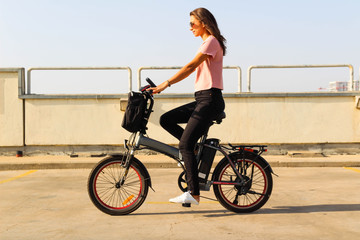Whether you are a fan or not, electric bikes are here to stay. Over the years, there has been an increase in demand for them. However, one question that many people have when considering an e-bike is whether or not the bike charges when you pedal. In this blog post, we will explore the answer to this question.
Do Electric Bikes Charge When You Pedal?
In general, electric bikes do not charge when you pedal. Electric bikes are powered by a battery and motor, which work together to assist the rider in pedaling. The battery is charged by plugging it into an electrical outlet or using a portable charging unit.

However, some electric bikes do have a feature called “regenerative braking” which allows the bike to convert some of the energy used during braking back into the battery. But this is not the same as charging when you pedal, it’s just a way of recovering some of the energy that would have been lost otherwise. Additionally, some electric bikes also have a solar charging option, which allows the bike to charge from solar panels during the day.
Do Electric Bikes Charge When You Pedal
Charging an electric bike’s battery is a straightforward process. It’s important to note that each e-bike manufacturer provides a charger and a manual with the bike. It’s recommended to follow the manufacturer’s instructions for the charger and the battery.
That said, here are the general steps to follow:
- Locate the battery: Electric bike batteries are typically located in the frame of the bike, often near the bottom bracket or the rear wheel.
- Check the battery level: Before charging, it’s a good idea to check the current battery level. Most electric bikes have a battery indicator on the handlebars or a display screen that will show the current battery level.
- Remove the battery from the bike: To charge the battery, you will need to remove it from the bike. This is typically done by unlocking a latch or pressing a release button.
- Connect the charger to the battery: Once the battery is removed, you will need to connect the charger to the battery. The charger will have a plug that connects to the battery’s charging port.
- Charge the battery: Plug the charger into an electrical outlet and wait for the battery to charge. The charging time will vary depending on the battery’s size and the charger’s amperage. It’s typically between 4-6 hours for a full charge.
- Replace the battery: Once the battery is fully charged, unplug the charger and replace the battery in the bike. Make sure to lock it securely in place.
What is Regenerative Braking in electric bikes?
Regenerative braking is a feature found in some electric bikes that allow the bike to convert some of the energy used during braking back into the battery. This can extend the range of the bike and reduce the need to charge the battery as frequently.
How Does It Work?
When the rider applies the brakes on an electric bike with regenerative braking, the bike’s motor acts as a generator, converting the kinetic energy of the bike’s motion into electrical energy. This electrical energy is then stored in the battery, effectively “recharging” it.
The amount of energy that can be recovered through regenerative braking depends on factors such as the bike’s speed, the rider’s braking force, and the bike’s settings. Regenerative braking can be adjusted on some electric bikes by adjusting the level of assist or by changing the settings on the bike’s display screen.
Regenerative braking is different from traditional mechanical brakes found in most bikes, which convert kinetic energy into heat through friction. Also, not all e-bikes have this feature, so it’s recommended to check with the manufacturer or the bike’s specifications before purchasing.
Why Is Regenerative Braking so Rare on Electric Bikes?
Regenerative braking is not as common on electric bikes as it is on other types of electric vehicles, such as electric cars, for a few reasons:
- Cost: Adding a regenerative braking system to an electric bike can add to the overall cost of the bike, which may make it less appealing to some buyers.
- Complexity: Adding regenerative braking to an electric bike requires a more complex motor and control system, which can increase the cost and complexity of the bike.
- Efficiency: In e-bikes, the regenerative braking effect is not as efficient as it is in cars, because of the lower weight and speed of the e-bike.
- Battery capacity: Electric bikes have smaller batteries which limit the amount of energy that can be recovered through regenerative braking.
- Different use case: Electric bikes are mostly used for commuting, recreational or short-distance travel, and the regenerative braking effect is not as significant as in other electric vehicles.
- Safety concerns: Regenerative braking can cause the bike to slow down more abruptly than traditional brakes. This can be a safety concern for some riders and may make the bike less appealing to some buyers.
Ultimately, the decision to include regenerative braking in an electric bike is a trade-off between cost, complexity, efficiency, and user preference.
Tips to Reduce Charge Consumption on Electric Bike’s Battery
Here are some tips to help reduce charge consumption on your electric bike’s battery:
- Many electric bikes have different levels of assist, which can be adjusted to match the terrain and your riding style. Using the appropriate level of assistance can help to reduce the amount of energy consumed by the motor.
- Some electric bikes have high-power features such as lights, horns, and other accessories that can consume more power. Only use these features when necessary, to help conserve the battery charge.
- If you’re going to be stopped for a while, it’s best to turn off your electric bike to conserve battery charge.
- Try to plan your route to avoid hilly terrain or areas with strong headwinds, which can consume more energy.
- If your bike is equipped with regenerative braking, use it to recover some of the energy that would have been lost otherwise.
- Regular maintenance such as keeping the tires inflated to the recommended pressure, and keeping the chain lubricated can help to reduce the amount of energy consumed while riding.
- When not in use, store the battery in a cool, dry place. Make sure to store the battery at a minimum of 50% charge to prevent over-discharge.
Conclusion
Electric bikes do not charge when you pedal but some features can help to extend the range of the bike, such as regenerative braking and solar charging. Both features can help extend the range of the bike and reduce the need to charge the battery as frequently.
However, it’s important to note that not all electric bikes have these features, and the effectiveness may vary depending on the bike’s settings and the rider’s pedaling effort. It’s also important to consider other ways to reduce charge consumption on your electric bike’s battery.
